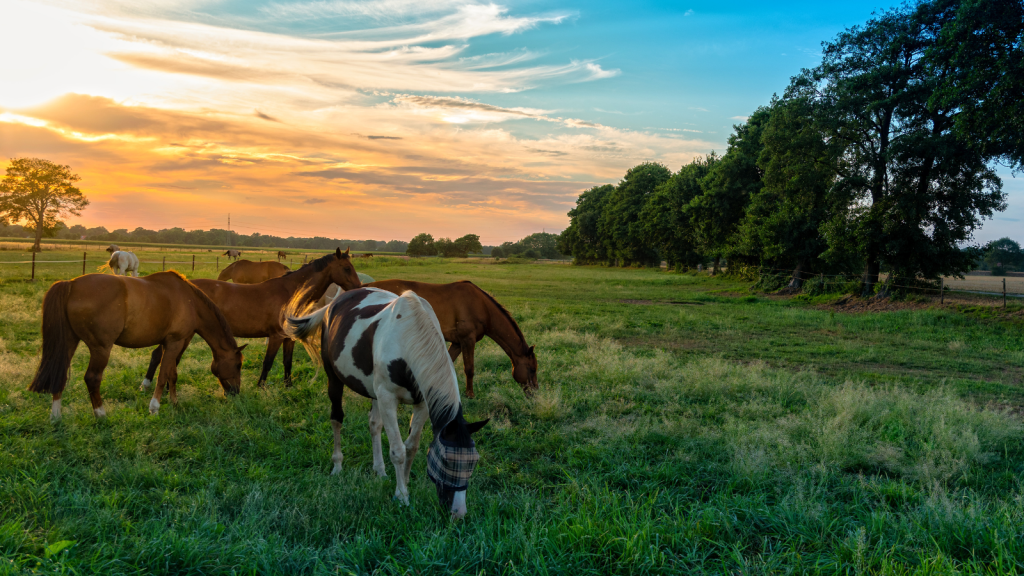Uncategorized
Managing Horse Pastures
Proper pasture management is essential for horse farm owners. From small hobby farms to large breeding and boarding operations, maintaining pastures takes work. Pasture maintenance includes pasture safety, regular mowing, pasture rotation, testing the soil, seeding, and fertilization.
Pasture Safety
Keeping horse pastures safe is imperative to your horse’s health and the first and most important part of pasture management. Horse pastures must have safe and secure fencing. Many different types of fencing can be used, but with all fencing it must be checked regularly to make sure there are no loose nails/boards, wires, or damage to it. Damage to fencing not only risks injury but it also would risk your horse getting out.
In addition to safe fencing, horse pastures need to be free of hazards and have access to fresh clean water. Essentially, almost anything can be a hazard to a horse so its important to be very careful at what you have inside of your pastures and note it is not the place to store your equipment, vehicles, trailers. Horses should always have access to fresh clean water. In the pasture you can provide this water with automatic waterers, large water troughs or regular buckets.
Pasture Health
There are a few different things to take into consideration when thinking about pasture health. You want to have your pastures tested so that you can maintain proper soil pH and nutrients. Iowa State Extension office recommends testing soil every 3 years (4). Grasses perform well when soils are pH between 6 and 7 (1) and they also need the right balance of nutrients (1). Nitrogen is critical for grasses, but applications need to be applied at the right amount and at the right time to see the most benefit.
Weeds can be a problem for horse pastures and must be managed. Weeds not only take away nutrients from the nutritious grazing grasses but they also can be toxic for horses. One way to help keep weeds down in a pasture is through rotational grazing. Horses are selective grazers and will over eat in their preferred areas, if pastures are rotated it allows the grasses to regrow without letting the weeds move in (2). Another way to help keep the weeds down is to make sure that you do not have more horses than the pasture acreage can support. The University of Minnesota equine extension recommends 2 acres of pasture per 1,000 pound horse (2). This acreage requirement can change vastly based on the vegetation in the pastures. For example, an acre of land in Lexington, Kentucky is likely much more vegetation dense than Phoenix, Arizona.
Mowing pastures at the right time can be helpful to help keep the pasture healthy. Mowing removes uneaten vegetation, weeds, and grass, and assists in regenerating healthy pasture growth. The grasses that grow back will be more palatable and nutritious (3). Along with mowing, manure removal and management in the pasture is going to play a roll in your pasture’s health. You want to make sure not to spread manure on pastures in the winter when the ground is frozen as plants aren’t growing or absorbing nutrients (4).
Pasture Nutrition
While horses have different nutritional needs, a well maintained and cared for pasture can provide most if not all the nutritional needs for many horses. Horse nutrition requirements vary significantly by breed, age, and activity level. Most three-day event or race horses will have significantly higher nutritional needs than a backyard trail horse and those sport horses will often require more than just what they have access to in pasture. Horses require 1.5% to 3% of their body weight intake daily to meet their nutritional needs (5). Keeping up with your pasture management can lower your overall feed costs as your horses are able to get their nutrition from pasture grazing.
To meet horse nutritional needs when pastures aren’t lush you can supplement your horses diet with hay and grain. Typically, most horse diets should be forage first, so if your pastures aren’t lush with grazing grasses, you would add hay first and then add concentrates.
Resources:
1 https://extension.psu.edu/basic-pasture-management-for-the-equine-owner
2 https://extension.umn.edu/horse-pastures-and-facilities/managing-established-horse-pastures
3 https://esc.rutgers.edu/fact_sheet/equine-pasture-management-a-year-round-approach/
4 https://www.extension.iastate.edu/equine/develop-pasture-management-calendar
6 https://equusmagazine.com/horse-care/limited-land-problem-30683/

